



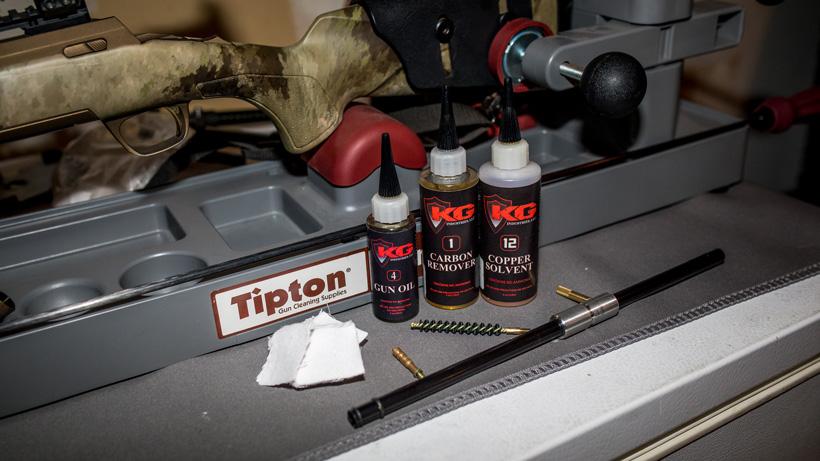
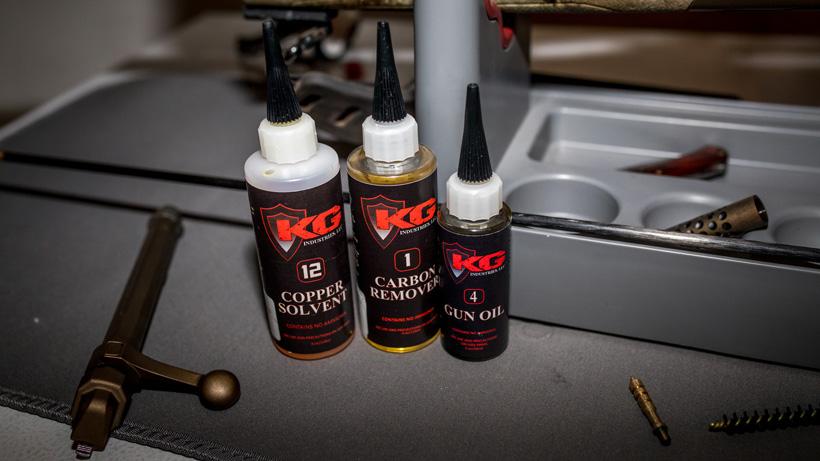
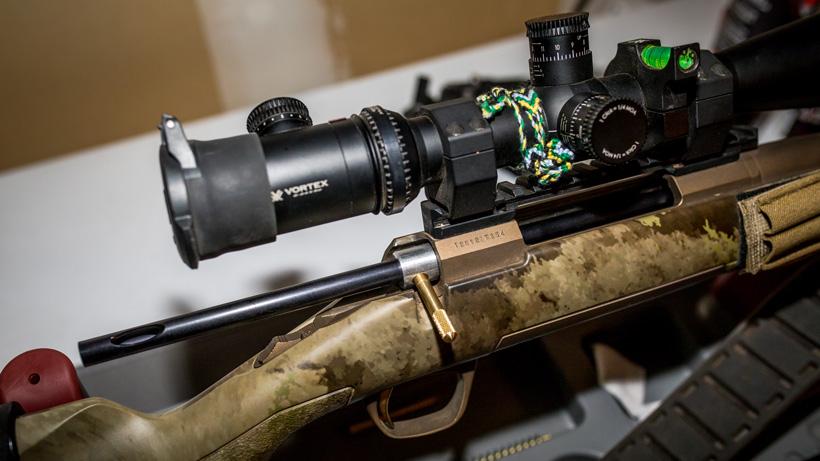
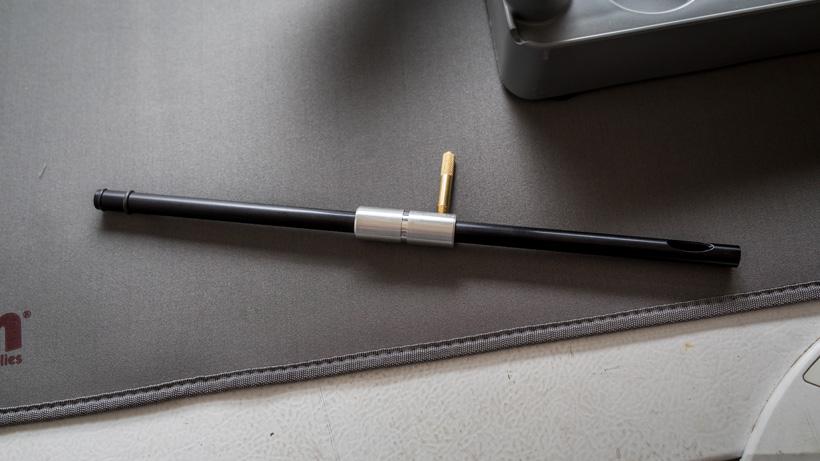
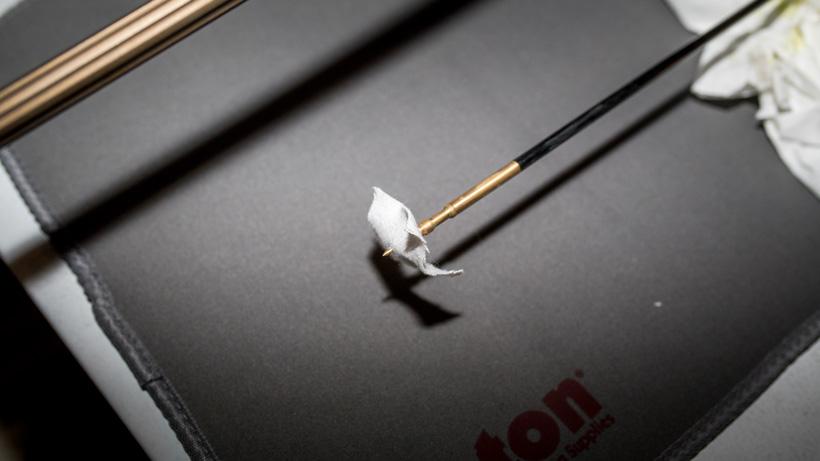
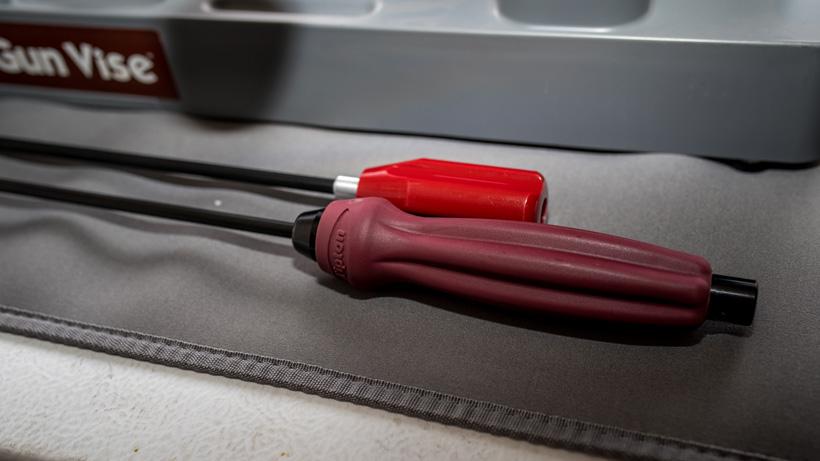
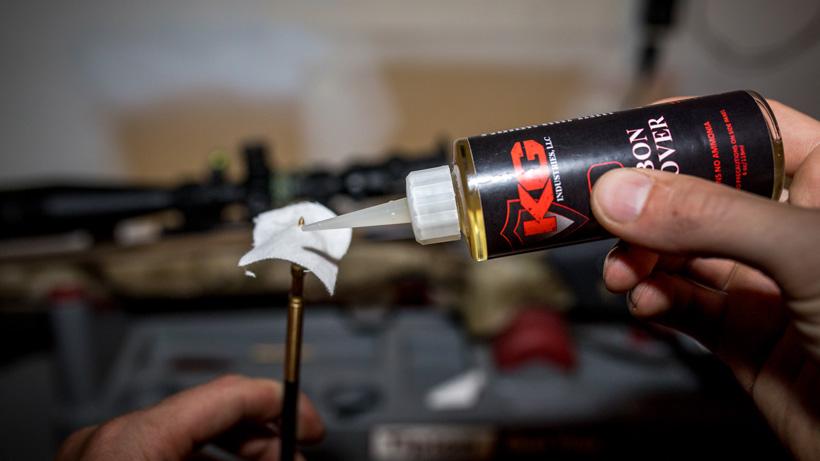
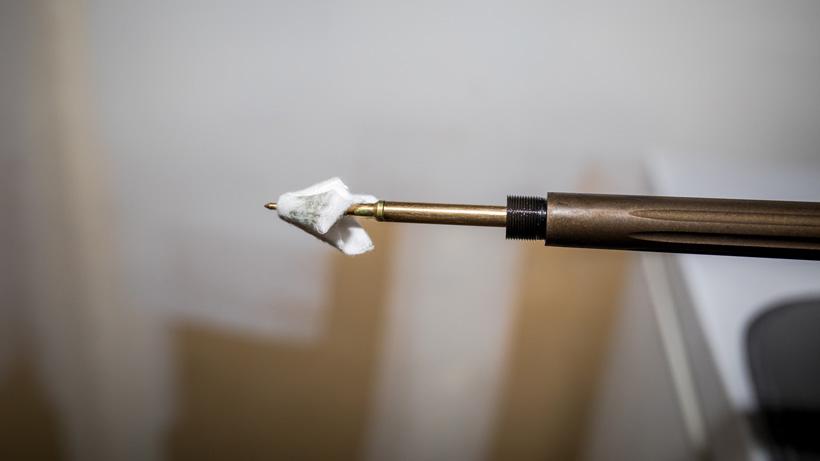
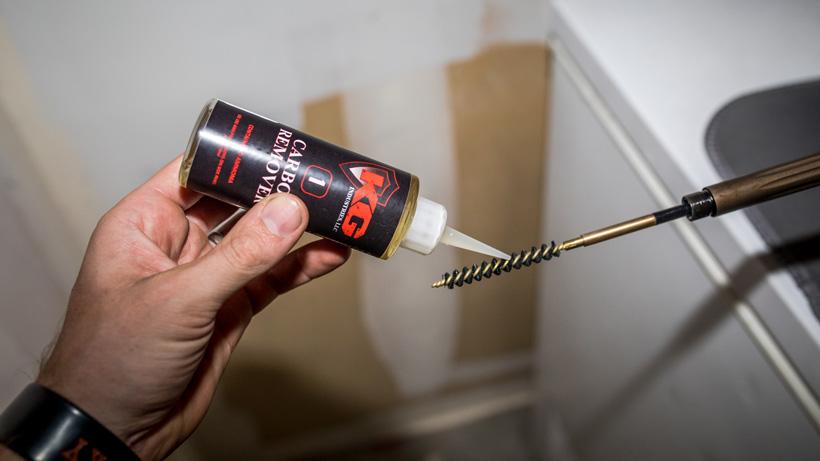
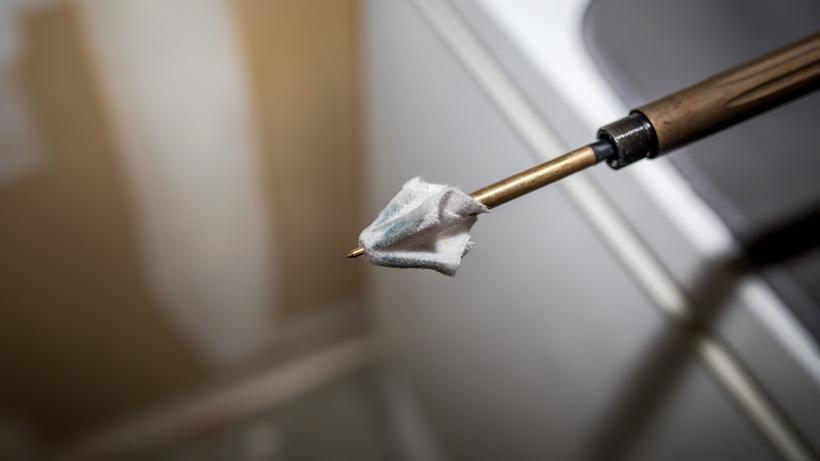
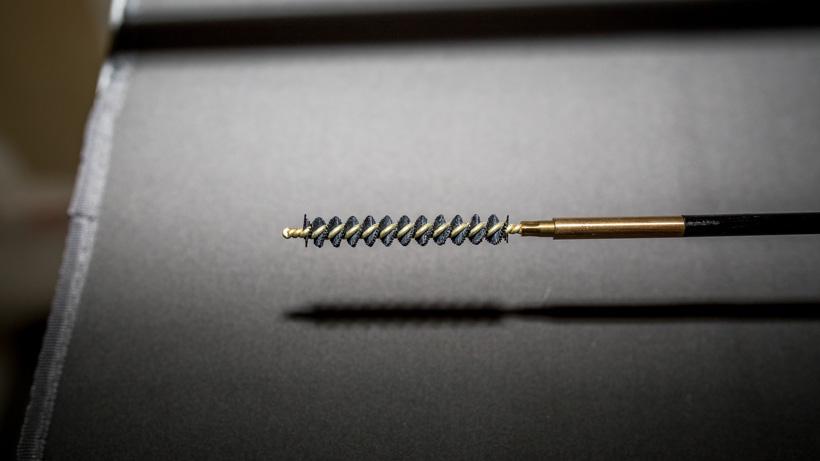
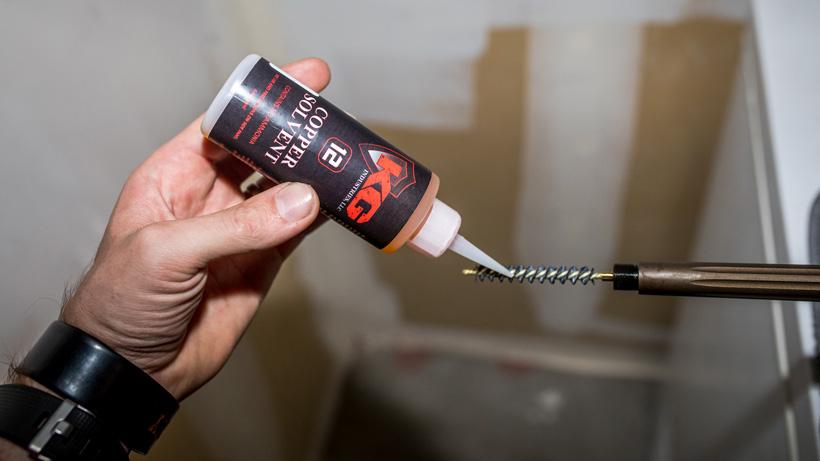
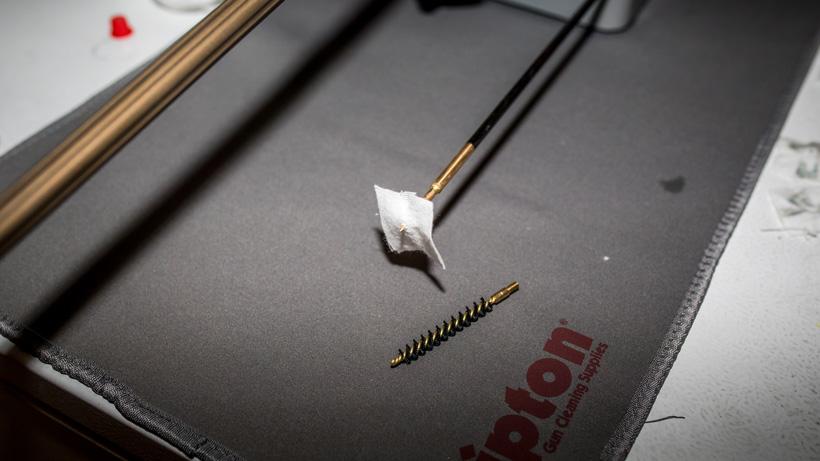
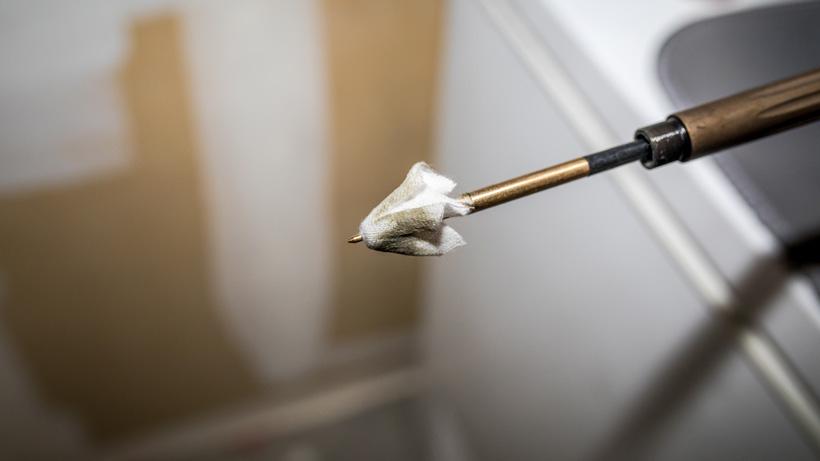
For demonstration purposes, I pushed the cleaning rod a little further through the barrel past the crown than I normally would.
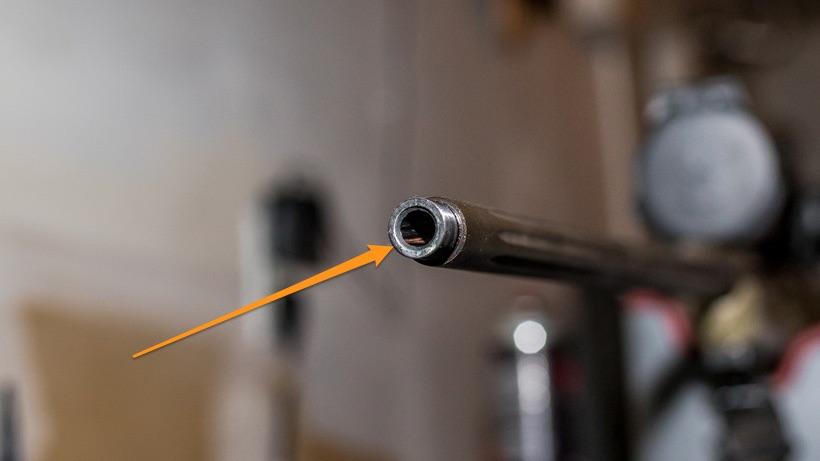
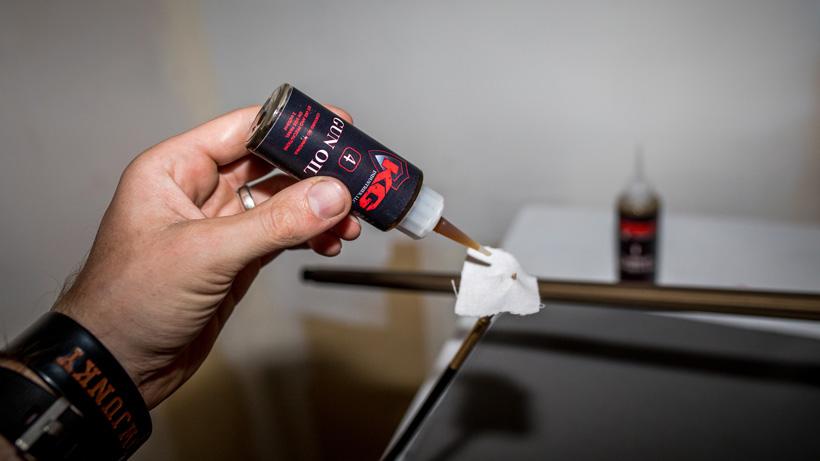
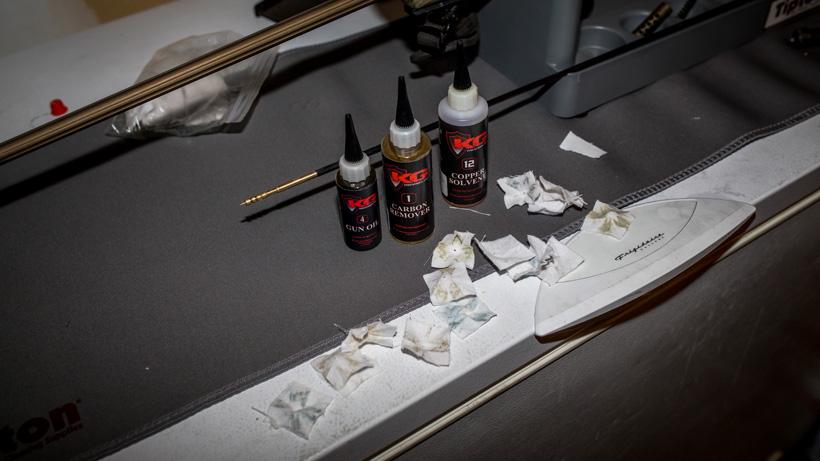
End results after cleaning hunting rifle bore.
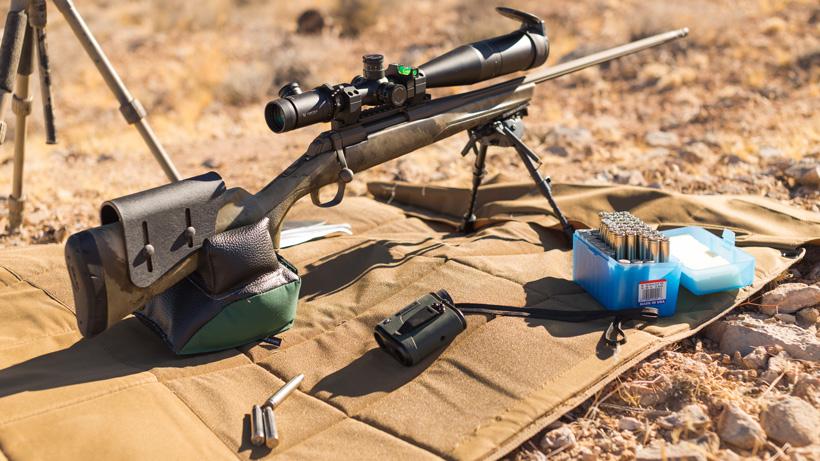
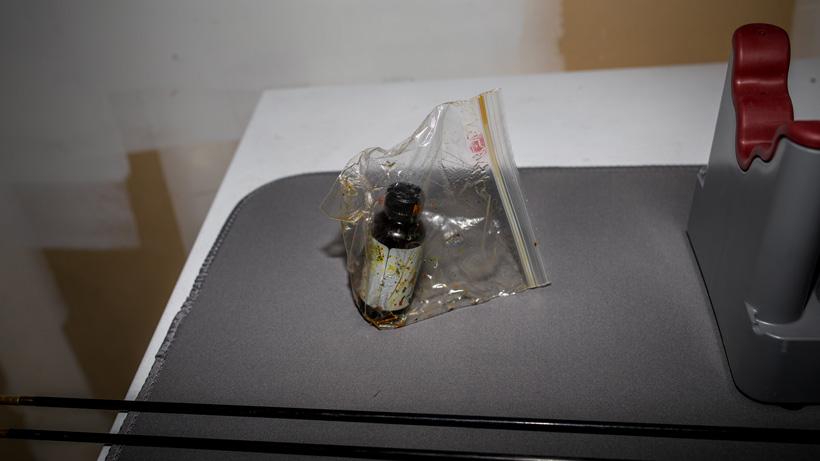
I’m a firm believer in cleaning your rifle throughout the season. Below are some steps that I’ve been using for a long time, which my father taught me, along with some modifications I’ve learned from others. I’ve said it before, but everything I’ve learned in long-range shooting has been from my dad. He has a wealth of knowledge when it comes to rifles. Over the years, some of the cleaning solvents I use have changed, but the general process remains the same for cleaning my hunting rifles. Now, before I get started, there are a plethora of ways to clean your hunting rifle barrel and lots of different brushes, mops, jags, etc that all work great. This is a method that has worked very well for me.
A semi-deep clean is probably the best way to describe this process, and it is my preferred way to get a rifle shooting where it’s supposed to after all the target practice to dial in my loads and dope chart. The process below is the same no matter what rifle I'm shooting. All of the photos below show this cleaning method with a Browning rifle I was working on for a family hunt.
When it comes to cleaning solvents for rifles, you can go down a million different rabbit holes. Some people will swear by one brand, and bash all the other cleaning methods, and others like some home brew mix (which is probably pretty scary unless you really know what you're doing).
We have two things we are basically trying to remove:
For the most part, I keep my cleaning solvent list pretty simple.
Notes on cleaning solvents: There are plenty of different options out there. My family and I have used Hoppes, KG Industries, Montana Extreme, SharpShoot-R (Patch Out and Accelerator), Shooter's Choice, Bore Tech (C4 Carbon Remover and CU+2 Copper Remover), Bullet Central (ThorroClean Bore Cleaner and ThorroClean Bore Flush), and Sweets throughout the years.
Just don't mix the chemicals and pick one system.
If I had to pick my favorites, it would be these:
Place your rifle in some sort of cleaning gun vise. If you don't have a gun vise, you can just extend your bipod. Note: Always clean your rifle with a cover over both sides of your riflescope. You don't want the solvents splatter or a cleaning brush to accidentally come into contact with your lens.
Remove the bolt and place the bore guide into the rifle. I like to use bore guides that have an O-ring to prevent cleaning material from re-entering the action. There are plenty of great rifle bore guides on the market. Some will work with lots of different rifles, or others are custom built to fit tighter.
I like to place a piece of leather over the rifle to protect my rifle stock from scratches from the cleaning rod rubbing across it, and also to prevent stains from any of the cleaning solvents.
Take a cleaning rod and attach the correct jag.
I start by pushing two or three patches through the barrel that are saturated with Bore Tech C4 Carbon Remover. This is meant as a way to saturate the bore and will remove some of the loose powder fouling.
So I take a cleaning patch, attach it to the jag, and place a few drops of carbon remover on the patch. Run the cleaning rod with the patch through the bore guide and down the bore, discard the patch, and repeat the process a few times. This process also shows some of the carbon fouling.
Note: When running the cleaning rod or brush down the bore, simply let the tip extend slightly beyond the end of the muzzle. This is an additional precaution to protect the crown of the barrel (still important even if a muzzle brake has been removed).
This process is ideal for removing a significant amount of stuff from the barrel. You’ll instantly notice that the first few patches are pretty dirty.
Leave the cleaning rod in the barrel after your last patch.
This process is very similar to the previous step, except that this time, you will be removing carbon from the barrel with a nylon brush.
Remember after the last step we left the cleaning rod in the barrel. Take your nylon brush and attach it to the cleaning rod. I prefer to do it this way, but you could have removed the cleaning rod, attached the brush and then put solvents on through a slot in your bore guide. I feel this method means less chance to spill something on your rifle.
Apply a few drops of your carbon remover solvent of choice to the nylon brush.
Now is the time to brush the bore as if you’re giving your teeth a thorough brushing. So, roughly you’ll want to run the brush through the bore 25 to 50 times. Again, be cautious to not damage the crown of your barrel if you removed your muzzle brake or suppressor.
Take the nylon brush and push it through the bore. Once the brush is exposed, apply a few drops of your carbon remover solvent of choice. Then it’s time to brush your teeth (rifle bore) another 25 to 50 plus times.
After that, again, run a few dry patches through the barrel and check the barrel for a clean look.
If you don’t have a clean finish, repeat the process a few more times.
This step is where you’ll work on the copper fouling. Attach the nylon brush to the rod and run it through the rifle bore (but don’t pull it back through).
Once through the bore, you will apply some drops of copper remover solvent to the brush. You could add the drops of solvent in the hole in your bore guide if you prefer. I definitely do it both ways depending on the conditions. Sometimes applying it to the bore end prevents the solvent from leaking onto your rifle stock and possibly discoloring it or impacting the laminate.
Now is the time to brush the bore as if you’re giving your teeth a thorough brushing. So, roughly you’ll want to run the brush through the bore 25 to 50 plus times.
Next, attach your jag and run a dry patch through the bore several times, and check the end of the barrel to see if you’ve removed all of the copper fouling.
If you still see copper fouling, then repeat the above steps a few times until it’s all removed.
Normally, the copper streaks appear as brownish-tinted streaks.
Take your cleaning rod and attach the jag and then place a patch on it. Next, apply a few drops of gun oil and run it back and forth through the bore a few times. After this, take a dry patch and run it through the bore to remove any excess gun oil.
I do think it’s wise to oil the bore after dry patching. I’ve used BT products for years, but I always leave oil in the bore after cleaning
For the most part, you don't want to hunt on a clean rifle barrel. I’ve had a few different rifles that seemed to respond differently after a thorough cleaning of the barrel. Some rifles shoot great from a super-cleaned bore, but others may not—all rifles are different. To be safe, I take a freshly cleaned rifle back out in the field and take a few foul shots to “settle a barrel down,” so to speak. When I'm at the range after a cleaned barrel, I like to shoot at a clean target face, and do a three or five shot string. And while doing this I'll watch the groups to see when they tighten up. Then I'll mark that down in a book that I keep on every single rifle, and I can compare that information the next time I do a deep clean.
There’s definitely a lot of reading that can be done on foul shots and bore mapping.
After you’ve completed all of these steps, your rifle is now ready for your next hunt!
Ending thought: Always remember to store your rifle cleaning solvents properly. This is what happens when you forget to screw the cap all the way down after some range practice.
This article was originally published on October 14, 2017, and has been updated.
Cleaning bench
Gun vice
Cleaning rod (carbon fiber or nylon)
Nylon brush (correct size)
Jag (correct size)
Patches
Bore guide
Carbon fouling
Copper fouling
Carbon remover
Copper fouling remover
Gun oil
Windex
SharpShoot-R
Bore Tech
Bullet Central
I use the top of a chest freezer in my garage so I don't get any solvent on my carpet and so I don't smell up my house.
I'll use a Tipton Gun Vice to secure my rifle when cleaning.
I prefer one-piece cleaning rods from Bore Tech (Bore Stix Rifle), Tipton carbon fiber, or J Dewey nylon-coated.
Nylon isn’t as harsh as other materials.
I use the Eliminator Premium Bore Brushes from Iosso.
I really like the stainless steel type material, so you don’t get a false copper reading. I use the Proof-Positive Rifle Patch Jags from Bore Tech.
Ensure they are the correct size for the rifle caliber.
I use the ones from PMA Tool.
Also can be called powder fouling. This is caused by the powder burn when you shoot.
This is caused by small amounts of the bullet jacket material being left in the barrel when you shoot.